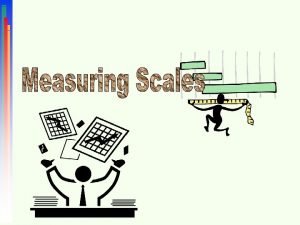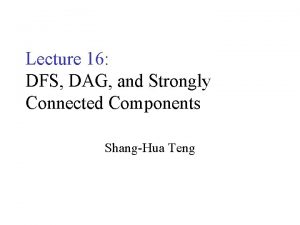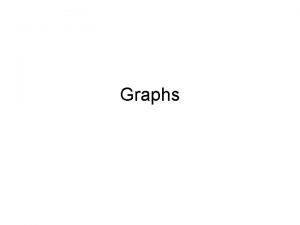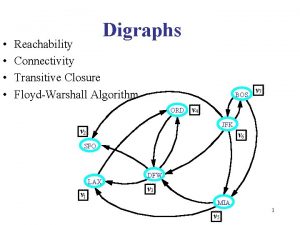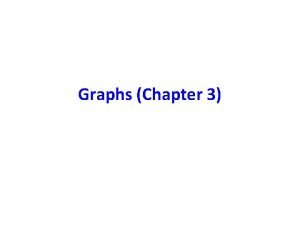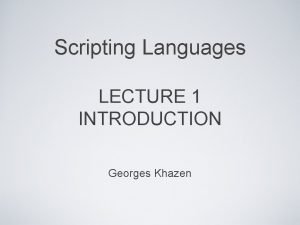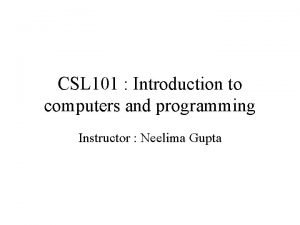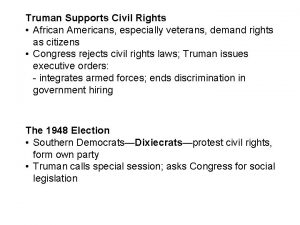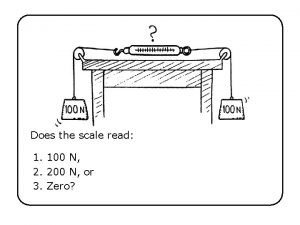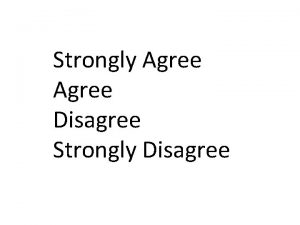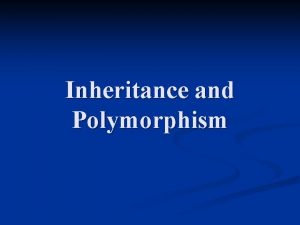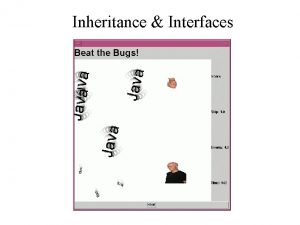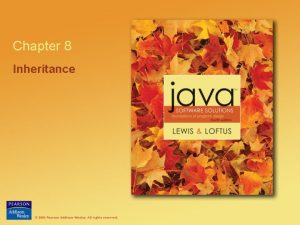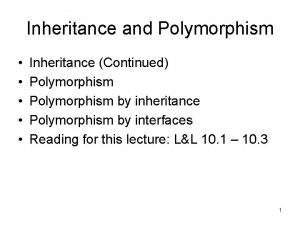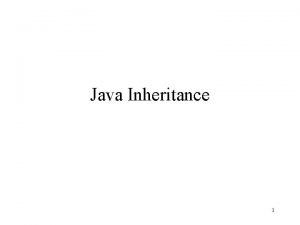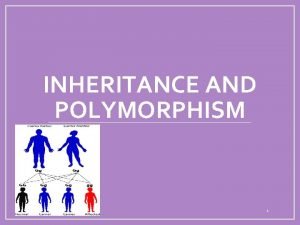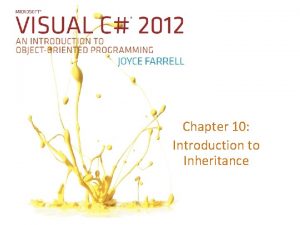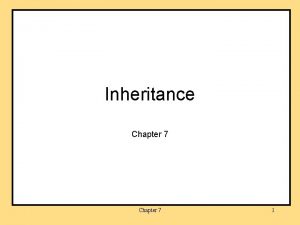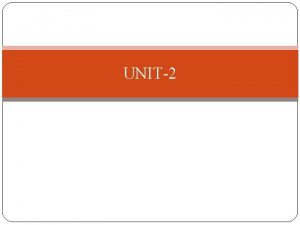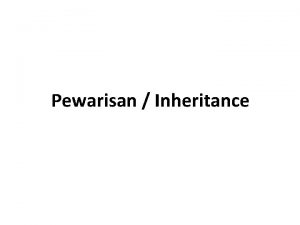Inheritance In C Inheritance C strongly supports the





































































- Slides: 69

Inheritance In C++

Inheritance C++ strongly supports the concept of Reusability. The mechanism of deriving a new class from an old class is called inheritance. The old class is referred to as Base class or Super class while the new class is referred to as the Derived class or Sub class. 2

Types of Inheritance Single Inheritance Multilevel Inheritance Multiple Inheritance Hierarchical Inheritance Hybrid Inheritance 3

Types of Inheritance 4

Inheritance Syntax: class derived_class_name : access_specifier base_class_name { // } Example: class derived : private base { }; class derived : public base { }; class derived : base { }; 5

Inheritance When a base class is publicly inherited by a derived class, “public members” of base class become “public members” of derived class and therefore they are accessible to the objects of the derived class. Private member of base class will never become the member of derived class derived : public base { }; When a base class is privately inherited by a derived class, “public members” of base class become “private members” of derived class and therefore the public member of base class can only be accessed by the member function of derived class. They are inaccessible to the object of the derived class derived : private base { }; 6

class B { int a; public: }; Class D : public B { int c; public : }; int main() { int b; void set_ab() { a=5; b=10; } int get_a() { return a; } void show_a() { cout<<“a = “<<a<<“n”; ; } void mul() { c = b * get_a(); // a can’t be used directly because it is private member of B class. } void display() { cout << “a = “<<get_a()<<“n”<<“b = “<<b<<“n”<<“c = “<<c<<“n”; } D d; d. set_ab(); d. mul(); d. show_a(); d. display(); d. b = 20; d. mul(); d. display(); return 0; 7

class B { int a; public: }; Class D : public B { int c; public : }; int main() { int b; void set_ab() { a=5; b=10; } int get_a() { return a; } void show_a() { cout<<“a = “<<a<<“n”; ; } void mul() { c = b * get_a(); Output: a=5 b=10 c=50 a=5 b=20 c=100 } void display() { cout << “a = “<<get_a()<<“n”<<“b = “<<b<<“n”<<“c = “<<c<<“n”; } D d; d. set_ab(); d. mul(); d. show_a(); d. display(); d. b = 20; d. mul(); d. display(); return 0; 8

class B { int a; public: }; Class D : private B { int c; public : }; int main() { } int b; void set_ab() { a=5; b=10; } int get_a() { return a; } void show_a() { cout<<“a = “<<a<<“n”; ; } void mul() { set_ab(); c = b * get_a(); } void display() { cout << “a = “<<get_a()<<“n”<<“b = “<<b<<“n”<<“c = “<<c<<“n”; } D d; d. mul(); d. display(); //d. show_a() //error return 0; 9

} class B { int a; public: }; Class D : private B { int c; public : }; int main() { } int b; void set_ab() { a=5; b=10; } int get_a() { return a; } void show_a() { cout<<“a = “<<a<<“n”; ; } void mul() { Output: a=5 b=10 c=50 set_ab(); c = b * get_a(); } void display() { cout << “a = “<<get_a()<<“n”<<“b = “<<b<<“n”<<“c = “<<c<<“n”; } D d; d. mul(); d. display(); //d. show_a() //error return 0; 10

Protected: Making a Private Member Inheritable C++ provides a third access specifier: protected A member declared as protected is accessible by the member functions within its class and any class immediately derived from it 11

• When a protected member is inherited in public mode it becomes protected in the derived class too and therefore is accessible by the member functions of the derived class. It is also ready for further inheritance. • A protected member, inherited in the private mode, becomes private in derived class. Although it is available to the member functions of the derived class, it is not available for further inheritance. • It is also possible to inherit a base class in protected mode. In this case both the public and protected members of the class become protected members of the derived class.

13

Multilevel Inheritance Class A serves as a base class for the derived class B, which in turn serves as a base class for the derived class C. The class B is known as intermediate base class. 14

class student { protected: int roll. No; public: void get. Roll. No(int a) { roll. No = a; } void put. Roll. No() { cout<<“Roll No “<<roll. No<<“n”; } }; class test : public student { protected: float sub 1; float sub 2; public : void get. Marks(float x, float y) { sub 1 = x; sub 2 = y; } void put. Marks() { cout << “Marks : “<<sub 1<<“ ”<<sub 2<<“n”; } }; 15

class result : public test { float total; public : void display() { total = sub 1 + sub 2; put. Roll. No(); put. Marks(); cout << “Total : “<<total<<“n”; } }; int main() { result student 1; student 1. get. Roll. No(123); student 1. get. Marks(75. 0, 65. 5); student 1. display(); return 0; } 16

class result : public test { float total; public : void display() { total = sub 1 + sub 2; put. Roll. No(); put. Marks(); cout << “Total : “<<total<<“n”; } }; Output: int main() { Roll No 123 result student 1; Marks : 75. 0 65. 5 Total : 140. 5 student 1. get. Roll. No(123); student 1. get. Marks(75. 0, 65. 5); student 1. display(); return 0; } 17

Multiple Inheritance Multiple inheritance allows us to combine the features of several existing classes as a starting point for defining new classes. 18

class M { protected: public: }; class N { protected: public: }; int m; void get. M(int a) { m = a; } int n; void get. N(int b) { n = b; } class P: public M, public N { public : void display() { cout << “m =“<<m<<“n =”<<n<<“m*n = “<<m*n<<“n”; } }; int main() { P p; p. get. M(10); p. get. N(20); p. display(); return 0; } 19

class M { protected: public: }; class N { protected: public: }; int m; void get. M(int a) { m = a; } int n; void get. N(int b) { n = b; } class P: public M, public N { public : void display() { cout << “m =“<<m<<“n =”<<n<<“m*n = “<<m*n<<“n”; } Output: }; int main() { m = 10 n = 20 m*n = 200 P p; p. get. M(10); p. get. N(20); p. display(); return 0; } 20

Ambiguity in Single Inheritance class A { public : }; class B: public A { public : void display() { cout << “A n”; } void display() { cout << “B n”; } }; int main() { B b; b. display(); return 0; } Which display() function get invoked? 21

Ambiguity in Single Inheritance class A { public : }; class B: public A { public : void display() { cout << “A n”; } void display() { cout << “B n”; } }; int main() { B b; b. display(); b. A: : display(); b. B: : display(); return 0; } Output: B A B 22

class A { }; class B { Ambiguity in Multiple Inheritance public : void display() { cout << “A n”; } void display() { cout << “B n”; } }; class C: public A, public B { }; int main() { C c; c. display(); return 0; } Which display() function get invoked? 23

class A { }; class B { Ambiguity in Multiple Inheritance public : void display() { cout << “A n”; } void display() { cout << “B n”; } }; class C: public A, public B { }; int main() { C c; c. display(); return 0; } Error: request for member 'display' is ambiguous 24

class A { }; class B { Ambiguity in Multiple Inheritance public : void display() { cout << “A n”; } void display() { cout << “B n”; } }; class C: public A, public B { public : void display() { A : : display(); } }; int main() { C c; c. display(); return 0; } Output: A 25

Hierarchical Inheritance The base class includes all the features that are common to subclasses. Any number of subclasses can be constructed by inheriting the properties of the base class. A subclass can serve as a base class for the lower level classes and so on. 26

Hybrid Inheritance There could be situations where we need to apply two or more types of inheritance to design a program. Multilevel + Multiple Inheritance 27

class student { protected: int roll. No; public: void get. Roll. No(int a) { roll. No = a; } void put. Roll. No() { cout<<“Roll No “<<roll. No<<“n”; } }; class test : public student { protected: float sub 1; float sub 2; public : void get. Marks(float x, float y) { sub 1 = x; sub 2 = y; } void put. Marks() { cout << “Marks : “<<sub 1<<“ ”<<sub 2<<“n”; } }; 28

class sports { protected: public : float score; void get. Score(float s) { score = s; } void put. Score() { cout << “Sports wt: “<<score<<“n”; } }; class result : public test, public sports { float total; public : void display() { total = sub 1 + sub 2 + score; put. Roll. No(); put. Marks(); put. Score(); cout << “Total : “<<total<<“n”; } }; int main() { result student 1; student 1. get. Roll. No(123); student 1. get. Marks(75. 0, 65. 5); student 1. get. Score(6. 0); student 1. display(); return 0; } 29

class sports { protected: public : float score; void get. Score(float s) { score = s; } void put. Score() { cout << “Sports wt: “<<score<<“n”; } }; class result : public test, public sports { float total; public : void display() { total = sub 1 + sub 2 + score; put. Roll. No(); put. Marks(); put. Score(); cout << “Total : “<<total<<“n”; } }; int main() { result student 1; student 1. get. Roll. No(123); student 1. get. Marks(75. 0, 65. 5); student 1. get. Score(6. 0); student 1. display(); return 0; } Output: Roll No 123 Marks : 75. 0 65. 5 Sports wt: 6. 0 Total : 146. 5 30

Virtual Base Classes • Consider a situation where all the three kinds of inheritance, namely, multilevel, multiple and hierarchical inheritance are involved. • The child has two direct base classes parent 1 and parent 2 which themselves have a common base class grandparent. The child inherits the traits of grandparents via two separate paths. It can also inherit directly as shown by the broken line. Grandparent referred as indirect base class.

• All the public and protected members of grand parent are inherited into child twice first via parent 1 and again via parent 2. This means child would have duplicate sets of members inherited from grandparents. This introduces ambiguity and should be avoided. • This duplication can be removed by making the common base class (ancestor class) as virtual base class while declaring the direct base classes as shown below.

• When a class is made a virtual base class, C++ takes care that only one copy of that class is inherited. • Consider again the student results processing system. Assume that the class sports derives the rollno from the class student. Then the inheritance relationship will be as shown in figure.

class student { protected: int roll. No; public: void get. Roll. No(int a) { roll. No = a; } void put. Roll. No() { cout<<“Roll No “<<roll. No<<“n”; } }; class test : virtual public student { protected: float sub 1; float sub 2; public : void get. Marks(float x, float y) { sub 1 = x; sub 2 = y; } void put. Marks() { cout << “Marks : “<<sub 1<<“ ”<<sub 2<<“n”; } }; 34

class sports: public virtual student { protected: float score; public : void get. Score(float s) { score = s; } void put. Score() { cout << “Sports wt: “<<score<<“n”; } }; class result : public test, public sports { float total; public : void display() { total = sub 1 + sub 2 + score; put. Roll. No(); put. Marks(); put. Score(); cout << “Total : “<<total<<“n”; } }; int main() { result student 1; student 1. get. Roll. No(123); student 1. get. Marks(75. 0, 65. 5); student 1. get. Score(6. 0); student 1. display(); return 0; } 35

class sports: public virtual student{ protected: float score; public : void get. Score(float s) { score = s; } void put. Score() { cout << “Sports wt: “<<score<<“n”; } }; class result : public test, public sports { float total; public : void display() { total = sub 1 + sub 2 + score; put. Roll. No(); put. Marks(); put. Score(); cout << “Total : “<<total<<“n”; } }; int main() { result student 1; student 1. get. Roll. No(123); student 1. get. Marks(75. 0, 65. 5); student 1. get. Score(6. 0); student 1. display(); return 0; } Output: Roll No 123 Marks : 75. 0 65. 5 Sports wt: 6. 0 Total : 146. 5 36

Constructors in Derived Classes • Constructor play an important role in initializing objects. • If no base class constructor takes any arguments, the derived class need not have a constructor function. • If any base class contains a constructor with one or more arguments, then it is mandatory for the derived class to have a constructor and pass the argument to the base class constructor. • When both the derived and base classes contain constructors, the base constructor is executed first then the constructor in derived class executed. • In case of multiple inheritance, the base classes are constructed in the order in which they appears in the declaration of the derived class. • Similarly in multilevel inheritance, the constructor will be executed in the order of inheritance.

• The constructor of the derived class receives the entire list of values as its arguments and passes them on to the base constructors in the order in which they are declared in the derived class. • The base constructors are called and executed before executing the statements in the body of the derived constructor.





Output: beta initialized alpha initialized gamma initialized x=5 y=10. 75 m=20 n=30 Note: beta is initialized first, although it appears second in the derived constructor.

#include<iostream> Using namespace std; class alpha { int x; public: alpha(int i) { x=i; cout<<“n alpha constructed”; } }; class beta { float p, q; public: beta(float a, float b): p(a), q(b+p) { cout <<“n beta constructed”; }

void show_beta(void) { cout<<“p = “<<q <<“n”; cout<< “ q =“<<q<<“n”; } }; class gamma : public beta, public alpha { int u, v; public: gamma(int a, int b, float c): alpha(a*2), beta(c, c), u(a) { v=b; cout<<“n gamma constructed”; } void show_gamma(void) { cout<<“u = “<< u<< “n”; cout<< “ v= “<<v<<“n”; } };

int main() { gamma g(2, 4, 2. 5); cout<<“n n display member values “<<“n n”; g. show_alpha(); g. show_beta(); g. show_gamma(); return 0; };

Int main() { gamma g(2, 4, 2. 5); cout<<“n n display member values “<<“n n”; g. show_alpha(); g. show_beta(); Output: g. show_gamma(); beta constructed alpha constructed return 0; gamma constructed }; Display member values X=4 P=2. 5 Q=5 U=2 V=4

“this” Pointer Ø Within a member function, the this keyword is a pointer to the current obj(object through which the fn was called). Ø The this pointer is a constant pointer. Ø Every obj has access to own add. through a ptr called this. Ø A static member function does not have a this pointer. Ø this pointer can be used inside the member functions only. Ø Member functions use this ptr implicitly or explicitly ØImplicitly when accessing members directly ØExplicitly when using keyword this

this pointer Example program #include<iostream> class test { private: int a; public: void setdata(int x) { a=x; // normal way to set data cout<<“address of my bject”<<this; this->a=x; // another way to set data } Address of my object : 0 X 22 fefc Address of object for showdata(): 0 X 22 fefc a=30; This->a 30 Address of my object : 0 X 22 fffc Address of object for showdata(): 0 X 22 fffc a=40; This->a 40 void showdata() { cout<<“n address of object for showdata()”<<this; cout<<“a=“<<a; cout<<“ this->a”<<this->a; } }; void main() { test t, s; t. setdata(30); t. showdata(); s. setdata(40); s. showdata(); The member function of a } class always with the pointer called this, which points to the object with which the function is invoked.

friend functions and classes Ø Private and protected members of a class cannot be accessible to out side the class. The non member functions cannot have an access to these data of a class. Ø When two classes need to access the same function- make such function to be friend to both the classes. Ø Allow the function to have access to the private members of these two classes. Ø Such a function need not be member function of any of these classes. Friend functions • Allow the non-member function to access even the private members of a class using the friend function or friend classes. • Friend functions are used to access private members of a class • syntax classname { …. . public: friend returntype functionname(object arg); };

Characteristics of friend function 1. 2. 3. 4. 5. 6. 7. 8. 9. 10. Function declaration is preceded by the keyword friend. Its not a member function of the class. However, access to private members of a class. The scope of the friend is not limited to the class in which it has been declared. Since it is not in the scope of the class, It cannot be invoked using the object of that class. Invoked like a normal function. It can be declared either in the public or the private part of a class. It takes object as an argument. Unlike the member functions, it cannot access the class members directly. However, it can use the object and dot operator with each member name to access both the private and public data. The function is defined any where in the program Function definition need not required any scope resolution operator.

Example on friend function Class xyz; // advanced class declaration class abc { private: int a; public: void setdata(int x) { a=x; } friend int add( abc ab, xyz xy); }; Class xyz { private: int b; public: void setdata(int y) { b=y; } friend int add( abc ab, xyz xy); }; int add( abc ab, xyz xy) { return ab. a+xy. b; }// a and b are private int main() { abc ab; xyz xy; ab. setdata(10); xy. setdata(20); cout<<“sum of the two no=“ <<add(ab, xy); return 0; }

Friend class • Whenever all the functions of one class can have access to the private members of the another class. • It is possible to make the entire class as a friend of another class. So that all the members of the friend class can have access to the private members of the another class. Syntax class A { ……. . ………………. . friend class B; }; Class B { ………. }

Example on friend class void main() class ABC { { ABC ab(10, 20); private: XYZ xy; //object of XYZ int a, b; xy. display(ab); public: } ABC(int x, int y) { a=x; b=y; } // make a class XYZ as friend class to ABC friend class XYZ; }; Display is function of friend class so that class XYZ{ pass class object as argument public: void display( ABC ab){ cout<<“n a in ABC class=“<<ab. a; cout<<“n b in ABC class=“<<ab. b; } };

What is Polymorphism? Polymorphism is the ability to use an operator or function in different ways. Polymorphism gives different meanings or functions to the operators or functions. A single function usage or an operator functioning in many ways can be called polymorphism. Polymorphism refers to codes, operations or objects that behave differently in different contexts.

Two type polymorphism Ø Function Overloading Ø Function Overriding Function overloading Ø Function overloading- The process of two or more functions having same name and different in their signature( no. of arguments, type of arguments). Ø However, the overloading function differ only in their return type is not allowed. Use of function overloading Ø Function overloading is one of the most powerful features of C++ programming language. It forms the basis of polymorphism (compile-time polymorphism). Ø Most of the time you’ll be overloading the constructor of a class.

• Swapping of two numbers void swap_int(int a, int b) { int temp; temp=a; a=b; b=temp; } Function overloading Void swap(int a, int b); Void swap(float a, float b); Void swap(char a, char b); void add(int a); void add(int a, int b); int add(int a, int b); last two functions are not overloading void swap_float(float a, float b) { float temp; temp=a; a=b; b=temp; }

Overloading Functions that differ in terms of no of arguments #include<iostream. h> //FUNTION PROTOTYPES int func(int i); int func(int i, int j); int main() { cout<<func(10); //func(int i)is called cout<<func(10, 10); //func(int i, int j) is called return 0; } int func(int i) { return i; } int func(int i, int j) { return i+j; }

• Overloading Functions that differ in terms of TYPE OF arguments #include<iostream. h> int func(int i); double func(double i); void main() { cout<<func(10); //func(int i)is called cout<<func(10. 201); //func(double i) is called } int func(int i) { return i; } double func(double i) { return i; }

include<iostream. h> int func(int i); double func(int i); int main() { cout<<func(10); cout<<func(10. 201); return 0; } int func(int i) { return i; } double func(int i) { return i; } This program wont work because you cant over load the functions if they are differ only in terms of data type they return. Write a c++ program to calculate area of circle, rectangle, square using function overloading. ?

#include "iostream" using namespace std; class measure { public: void shape(int r){ cout<<"area of the circle is "<<3. 14*r*r; } void shape(int l, int b) { cout<<"area of the rectangle is"<<l*b; } void shape(long a) { cout<<"area of the square is"<<a*a; } };

int main() { int r, d, e, l, b; float t, c, h; long a; int ch; double j, f; long int g; measure obj; cout<<"t. CALCULATION OF AREA AND VOLUME"; cout<<"nn 1. area of circle"; cout<<"n 2. area of rectangle"; cout<<"n 3. area of square"; cout<<"nt. Enter your choice "; cin>>ch;

switch(ch){ case 1: cout<<"enter the value of radius of the circle n"; cin>>r; obj. shape(r); break; case 2: cout<<"enter the sides of rectangle n"; cin>>l>>b; obj. shape(l, b); break; case 3: cout<<"enter the sides of square"; cin>>a; obj. shape(a); break; default: cout<<"n. The choice entered is a wrong choice"; } }

Function Overriding • If we inherit a class into the derived class and provide a definition for one of the base class's function again inside the derived class, then that function is said to be overridden, and this mechanism is called Function Overriding.

• To access the overridden function of the base class from the derived class, scope resolution operator : : is used. For example

Q 1. Write a program in C++ to create a class Time. The class should have three fields for hours, minutes and seconds. It should have constructor to initialize the hours, minutes and seconds and a method print. Time() to print the time. Overload the following operators: plus operator (+) (add two time objects based on 24 hour clock) and minus operator (-) (sub two time objects based on 24 hour clock)

#include using namespace std; class Time { private: int hr, min, sec; public: Time(); // constructor Time(int, int); // constructor void get(); void show(); Time operator + (Time); Time operator - (Time); }; Time: : Time() { hr=0; min=0; sec=0; } Time: : Time(int h, int m, int s) { hr=h; min=m; sec=s; } void Time: : get() { cout<<"n. Enter hrs: "; cin>>hr; cout<<"Enter min: "; cin>>min; cout<<"Enter sec: "; cin>>sec; } void Time: : show() { cout<<"Time is "<<hr<<": "<<min<<": "<<sec<<endl; }

Time: : operator + ( Time t) { int h, m, s; int sum; sum = (hr + t. hr)*3600 + (min + t. min)*60 + sec + t. sec; s = sum % 60; sum = sum / 60; m = sum % 60; h = sum / 60; return Time(h, m, s); } Time: : operator - ( Time t) { int h, m, s; int sum 1, sum 2, sum; sum 1 = (hr)*3600 + (min )*60 + sec ; sum 2 = (t. hr)*3600 + (t. min)*60 + t. sec; if (sum 1>sum 2) sum = sum 1 -sum 2; else sum = sum 2 -sum 1;

s = sum %60; sum = sum/60; m = sum % 60; h = sum/60; return Time(h, m, s); } int main() { Time t 1; Time t 2; cout<<"Enter first time: "; t 1. get(); cout<<"Enter second time: "; t 2. get(); Time t_sum = t 1 + t 2; Time t_diff = t 1 - t 2; cout<<"Sum "; t_sum. show(); cout<<"Diff "; t_diff. show(); system("pause"); }
 Vegetable classifications
Vegetable classifications Itemized scale example
Itemized scale example Logos definition literature
Logos definition literature Strongly connected components applications
Strongly connected components applications Strongly connected components
Strongly connected components Thermal decomposition of calcium carbonate
Thermal decomposition of calcium carbonate Strongly typed vs weakly typed
Strongly typed vs weakly typed Worse than slavery cartoon
Worse than slavery cartoon Strongly connected
Strongly connected When do density dependent factors operate most strongly
When do density dependent factors operate most strongly Topological sort can be implemented by?
Topological sort can be implemented by? Jordi cortadella
Jordi cortadella 8 vegetable classifications
8 vegetable classifications Strongly connected components
Strongly connected components Which word most strongly appeals to pathos?
Which word most strongly appeals to pathos? I strongly recommend this book
I strongly recommend this book Latitude strongly influences climate because
Latitude strongly influences climate because Agree disagree
Agree disagree India is strongly influenced by monsoon winds
India is strongly influenced by monsoon winds Semantic satiation
Semantic satiation Kosarajus
Kosarajus Strongly typed scripting language
Strongly typed scripting language Difference between strongly and weakly typed languages
Difference between strongly and weakly typed languages Các châu lục và đại dương trên thế giới
Các châu lục và đại dương trên thế giới Chụp tư thế worms-breton
Chụp tư thế worms-breton Thế nào là hệ số cao nhất
Thế nào là hệ số cao nhất ưu thế lai là gì
ưu thế lai là gì Sơ đồ cơ thể người
Sơ đồ cơ thể người Tư thế ngồi viết
Tư thế ngồi viết Cái miệng bé xinh thế chỉ nói điều hay thôi
Cái miệng bé xinh thế chỉ nói điều hay thôi đặc điểm cơ thể của người tối cổ
đặc điểm cơ thể của người tối cổ Cách giải mật thư tọa độ
Cách giải mật thư tọa độ Bổ thể
Bổ thể Tư thế ngồi viết
Tư thế ngồi viết Thẻ vin
Thẻ vin Thơ thất ngôn tứ tuyệt đường luật
Thơ thất ngôn tứ tuyệt đường luật Bài hát chúa yêu trần thế alleluia
Bài hát chúa yêu trần thế alleluia Các châu lục và đại dương trên thế giới
Các châu lục và đại dương trên thế giới Từ ngữ thể hiện lòng nhân hậu
Từ ngữ thể hiện lòng nhân hậu Diễn thế sinh thái là
Diễn thế sinh thái là Vẽ hình chiếu vuông góc của vật thể sau
Vẽ hình chiếu vuông góc của vật thể sau V cc
V cc 101012 bằng
101012 bằng Tỉ lệ cơ thể trẻ em
Tỉ lệ cơ thể trẻ em Lời thề hippocrates
Lời thề hippocrates Hươu thường đẻ mỗi lứa mấy con
Hươu thường đẻ mỗi lứa mấy con đại từ thay thế
đại từ thay thế Quá trình desamine hóa có thể tạo ra
Quá trình desamine hóa có thể tạo ra Công thức tính độ biến thiên đông lượng
Công thức tính độ biến thiên đông lượng Thế nào là mạng điện lắp đặt kiểu nổi
Thế nào là mạng điện lắp đặt kiểu nổi Hình ảnh bộ gõ cơ thể búng tay
Hình ảnh bộ gõ cơ thể búng tay Dạng đột biến một nhiễm là
Dạng đột biến một nhiễm là Nguyên nhân của sự mỏi cơ sinh 8
Nguyên nhân của sự mỏi cơ sinh 8 Vẽ hình chiếu đứng bằng cạnh của vật thể
Vẽ hình chiếu đứng bằng cạnh của vật thể Phản ứng thế ankan
Phản ứng thế ankan Gấu đi như thế nào
Gấu đi như thế nào Các môn thể thao bắt đầu bằng tiếng đua
Các môn thể thao bắt đầu bằng tiếng đua Thiếu nhi thế giới liên hoan
Thiếu nhi thế giới liên hoan Khi nào hổ mẹ dạy hổ con săn mồi
Khi nào hổ mẹ dạy hổ con săn mồi điện thế nghỉ
điện thế nghỉ Một số thể thơ truyền thống
Một số thể thơ truyền thống Trời xanh đây là của chúng ta thể thơ
Trời xanh đây là của chúng ta thể thơ Lp html
Lp html Các số nguyên tố
Các số nguyên tố Fecboak
Fecboak Truman supports civil rights
Truman supports civil rights Multimedia management system
Multimedia management system Smacna hangers and supports
Smacna hangers and supports Fibers
Fibers She holds the book stationary against the wall
She holds the book stationary against the wall

